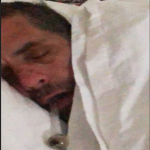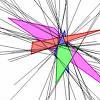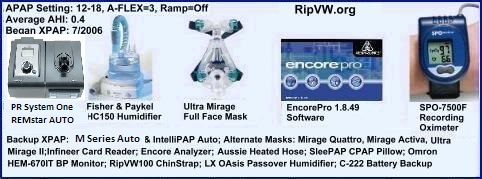Is APAP really "better" than CPAP?
- TossinNTurnin
- Posts: 243
- Joined: Sat Jan 05, 2008 7:45 pm
Is APAP really "better" than CPAP?
Most people here seem to think it's "better", but I noticed one person on here said their doctor thinks that CPAP is more effective.
Can these Automatic machines be trusted to "titrate" accurately?
I'm sorry if these are stupid questions...
Can these Automatic machines be trusted to "titrate" accurately?
I'm sorry if these are stupid questions...
"She is a singer, and therefore capable of anything" Vincenzo Bellini
Zoo Med Repti Heat cable to prevent rainout and the Aussie heated hose
Zoo Med Repti Heat cable to prevent rainout and the Aussie heated hose
- DreamStalker
- Posts: 7509
- Joined: Mon Aug 07, 2006 9:58 am
- Location: Nowhere & Everywhere At Once
-
Bearded_One
- Posts: 597
- Joined: Fri Nov 17, 2006 9:35 am
- Location: Northern Virginia, near DC
I actually "titrated" myself on my Pro 2 (data capable) CPAP. I finally got around to buying my first Auto about a year later and after a week, found out that I was right on. My AHI numbers were actually a little bit higher during the time I used mine in a range of pressures, so I use CPAP mode.
My criteria is first and foremost a data capable machine and the software to interpret the data.
As far as I know, ALL APAPs are data capable, so that's one thing in their favor..
Like DreamStalker said, you can run an APAP in CPAP mode if/when you decide which type of therapy works best for you.
If you DON'T get an Auto......DON'T feel bad. You can still do this therapy without one.
Den
My criteria is first and foremost a data capable machine and the software to interpret the data.
As far as I know, ALL APAPs are data capable, so that's one thing in their favor..
Like DreamStalker said, you can run an APAP in CPAP mode if/when you decide which type of therapy works best for you.
If you DON'T get an Auto......DON'T feel bad. You can still do this therapy without one.
Den
(5) REMstar Autos w/C-Flex & (6) REMstar Pro 2 CPAPs w/C-Flex - Pressure Setting = 14 cm.
"Passover" Humidification - ResMed Ultra Mirage FF - Encore Pro w/Card Reader & MyEncore software - Chiroflow pillow
User since 05/14/05
"Passover" Humidification - ResMed Ultra Mirage FF - Encore Pro w/Card Reader & MyEncore software - Chiroflow pillow
User since 05/14/05
The autoPAP provides no better THERAPY than a fully data capable CPAP -'if' your lab titration was accurate.
_________________
| Mask: Quattro™ FX Full Face CPAP Mask with Headgear |
| Additional Comments: PR SystemOne BPAP Auto w/Bi-Flex & Humidifier - EncorePro 2.2 Software - Contec CMS-50D+ Oximeter - Respironics EverFlo Q Concentrator |
Women are Angels. And when someone breaks our wings, we simply continue to fly.....on a broomstick. We are flexible like that.
My computer says I need to upgrade my brain to be compatible with its new software.
My computer says I need to upgrade my brain to be compatible with its new software.
APAP or CPAP
Couple more differences - With APAP and a range of pressure, some of the night you can be at a lower pressure and it will increase if there is a need. With CPAP your pressure is set at your highest need to cover all events, but most machines have a feature for exhalation relief so one is not breathing out against the same pressure on inhalation.
I've used both. Can't say I've experienced much difference in comfort. Having an APAP for an occassional titration check is in my opinion a significant benefit, though not a necessity. I agree with the others who said that data capability is the greater issue.
Kathy
I've used both. Can't say I've experienced much difference in comfort. Having an APAP for an occassional titration check is in my opinion a significant benefit, though not a necessity. I agree with the others who said that data capability is the greater issue.
Kathy
_________________
| Mask: TAP PAP Nasal Pillow CPAP Mask with Improved Stability Mouthpiece |
| Humidifier: S9™ Series H5i™ Heated Humidifier with Climate Control |
| Additional Comments: Bleep/DreamPort for full nights, Tap Pap for shorter sessions |
My SleepDancing Video link https://www.youtube.com/watch?v=jE7WA_5c73c
What they all said...
O.
O.
_________________
| Mask: AirFit™ P10 Nasal Pillow CPAP Mask with Headgear |
| Additional Comments: Machine: Resmed AirSense10 for Her with Climateline heated hose ; alternating masks. |
And now here is my secret, a very simple secret; it is only with the heart that one can see rightly, what is essential is invisible to the eye.
Antoine de Saint-Exupery
Good advice is compromised by missing data
Forum member Dog Slobber Nov. 2023
Antoine de Saint-Exupery
Good advice is compromised by missing data
Forum member Dog Slobber Nov. 2023
cpap apap
Even if I am a virtual non-compliant user after 3 months, I still think it's good to have an APAP machine that I run on CPAP. All this is still new and I have yet to get my card reader to actually see what's going on. However I started with APAP 4-16 and found I couldn't breath with so low a pressure. Then I increased it eventually to 8-14, but was still woken by the changing pressure. So I altered it to CPAP to the sleep lab titrated pressure of 12, no ramp (but I do have EPR set at 3) and found it 'reasonable'. I still have to sleep a whole night with it on, but it IS better! I believe that when I get a bit better and learn the software etc , I'll re-titrate again to confirm pressures. I think it's worth it just to have this option.
Cheers
Michael
Cheers
Michael
Michael
I was titrated at a pressure of 14 and used straight CPAP for the first 6 weeks or so with a hired machine. I found it quite a struggle at this pressure to get used to the force of the airflow, and to get a seal on any mask I tried. I did in time get used to it and would amazingly wake to find I was not sure if the machine was blowing or not, and I did not really have trouble breathing out, although this is a big problem for many. My main problems related to keeping a seal and skin problems from the pressure of the mask.
When I purchased my own APAP data-capable machine, I found the whole experience much more comfortable. I do occasionally need a pressure of 14, but usually only for a few minutes at a time. I have changed my range of pressures from 6-16 to 10-16 because I could see in my data that this gave me the best results for all events. My AHI usually doesn't exceed 2 and other events such as flow limitations and vibratory snores are much less than when my range was 6-16.
Just to experiment, one night recently I set my machine to straight CPAP at 14 - I haven't done it again. I did not sleep well with leaking mask problems and was not used to the strong pressure all night. So, my conclusion is that if your pressure is relatively high, then APAP might be the more comfortable way to go, but with a lower pressure, say 10-11 or less, then it may not make a difference.
Beegee
When I purchased my own APAP data-capable machine, I found the whole experience much more comfortable. I do occasionally need a pressure of 14, but usually only for a few minutes at a time. I have changed my range of pressures from 6-16 to 10-16 because I could see in my data that this gave me the best results for all events. My AHI usually doesn't exceed 2 and other events such as flow limitations and vibratory snores are much less than when my range was 6-16.
Just to experiment, one night recently I set my machine to straight CPAP at 14 - I haven't done it again. I did not sleep well with leaking mask problems and was not used to the strong pressure all night. So, my conclusion is that if your pressure is relatively high, then APAP might be the more comfortable way to go, but with a lower pressure, say 10-11 or less, then it may not make a difference.
Beegee
Hmmm... while I agree that straight CPAP provides better therapy for some, I also think that if you are going to use your machine for several years, you need the ability to make changes in your pressure for life's variables. APAP lets you "re-titrate" yourself whenever you feel that your therapy isn't working the way it should. My APAP also has algorithms for snore detection, flow limitation, command on apnea, and detection of central apneas - all valuable data, in my opinion.Wulfman Said:
My criteria is first and foremost a data capable machine and the software to interpret the data.
As far as I know, ALL APAPs are data capable, so that's one thing in their favor..
Like DreamStalker said, you can run an APAP in CPAP mode if/when you decide which type of therapy works best for you.
Just my 2 cents,
Cathy
I used CPAP for over a year, set to my sleep study pressure, with little/no results from my therapy. After finding this forum, I decided to purchase my APAP--the auto titration established my pressure at twice that of the sleep study (from 6.0 to 12.0)! Since then, my therapy has been effective, feel SO much better, rested . . . So, for me, there is no question--APAP RULES! And, as others have said, you can always choose to run the APAP in CPAP mode. I keep my machine in APAP/auto mode--usually it maintains a fairly constant pressure around 12.0, but some nights it will automatically raise pressure in response to a more stubborn event.

"You are getting sleepy . . ."

"You are getting sleepy . . ."
- DreamStalker
- Posts: 7509
- Joined: Mon Aug 07, 2006 9:58 am
- Location: Nowhere & Everywhere At Once
"Is APAP really "better" than CPAP?"
I guess if you are referring to “APAP therapy” vs “CPAP therapy” ... each person is different -- some do better with straight CPAP while others do better with APAP. The only way to know is to try both types of therapy and see what works for you. However if you only have a straight CPAP machine, you will never know if APAP therapy is better for you will you?
If you are referring to “APAP machine” vs “CPAP machine” ... the answer is quite obvious to me. As I said before, an APAP machine can be set to work in CPAP mode but CPAP machine cannot work as an APAP. If you already know that you and APAP do not work well together, then I suppose a CPAP machine is better for you ... otherwise an APAP machine is the best choice.
Accuracy of titration? ...
You need only to read the threads and posts by Dr. Karkow to realize that "accurate" titration is something that even most sleep labs are not capable of doing without specially trained staff and doctors using bi-level machines (and also requires several titration iterations to get it right). Accurate titration is a relative thing … unless you go and get treated by someone like Dr. Karkow, you are likely to do just as well or better with an APAP machine and monitoring software (plus a little help from our forum members) than your typical local sleep center IMO. Most sleep centers and their staff are not up to the level of expertise to do an accurate titration any better than a well informed OSA patient.
So if you do not want to be bothered with informing yourself about your condition or treatment and you have complete trust in your healthcare providers, then just get yourself what ever machine they give you and hope for the best.
I guess if you are referring to “APAP therapy” vs “CPAP therapy” ... each person is different -- some do better with straight CPAP while others do better with APAP. The only way to know is to try both types of therapy and see what works for you. However if you only have a straight CPAP machine, you will never know if APAP therapy is better for you will you?
If you are referring to “APAP machine” vs “CPAP machine” ... the answer is quite obvious to me. As I said before, an APAP machine can be set to work in CPAP mode but CPAP machine cannot work as an APAP. If you already know that you and APAP do not work well together, then I suppose a CPAP machine is better for you ... otherwise an APAP machine is the best choice.
Accuracy of titration? ...
You need only to read the threads and posts by Dr. Karkow to realize that "accurate" titration is something that even most sleep labs are not capable of doing without specially trained staff and doctors using bi-level machines (and also requires several titration iterations to get it right). Accurate titration is a relative thing … unless you go and get treated by someone like Dr. Karkow, you are likely to do just as well or better with an APAP machine and monitoring software (plus a little help from our forum members) than your typical local sleep center IMO. Most sleep centers and their staff are not up to the level of expertise to do an accurate titration any better than a well informed OSA patient.
So if you do not want to be bothered with informing yourself about your condition or treatment and you have complete trust in your healthcare providers, then just get yourself what ever machine they give you and hope for the best.
President-pretender, J. Biden, said "the DNC has built the largest voter fraud organization in US history". Too bad they didn’t build the smartest voter fraud organization and got caught.
My primary "defense" of CPAP machines on this forum is:
If all you can get out of your prescribing physcian/insurance/DME is a data-collecting CPAP......don't feel like a 2nd class CPAPper. I HATE it when "APAP users" tend to make the new users feel like they can't do this therapy unless they have an APAP......and if they don't have one, they're SOL. That's just not necessarily true.
90+% of this therapy is getting the right mask.
APAPs are more expensive. (depending on insurance coverage and other economic factors, many people may not be able to afford them)
Going through the "normal" physcian/insurance/DME route could be an exercise in frustration to get one. Sometimes it's hard enough to get a data-capable machine out of some of these folks.....which should be considered a "crime" to deprive the users of the capability of monitoring their own therapy.
Den
If all you can get out of your prescribing physcian/insurance/DME is a data-collecting CPAP......don't feel like a 2nd class CPAPper. I HATE it when "APAP users" tend to make the new users feel like they can't do this therapy unless they have an APAP......and if they don't have one, they're SOL. That's just not necessarily true.
90+% of this therapy is getting the right mask.
APAPs are more expensive. (depending on insurance coverage and other economic factors, many people may not be able to afford them)
Going through the "normal" physcian/insurance/DME route could be an exercise in frustration to get one. Sometimes it's hard enough to get a data-capable machine out of some of these folks.....which should be considered a "crime" to deprive the users of the capability of monitoring their own therapy.
Den
(5) REMstar Autos w/C-Flex & (6) REMstar Pro 2 CPAPs w/C-Flex - Pressure Setting = 14 cm.
"Passover" Humidification - ResMed Ultra Mirage FF - Encore Pro w/Card Reader & MyEncore software - Chiroflow pillow
User since 05/14/05
"Passover" Humidification - ResMed Ultra Mirage FF - Encore Pro w/Card Reader & MyEncore software - Chiroflow pillow
User since 05/14/05
- Flying_Norseman
- Posts: 321
- Joined: Fri Sep 07, 2007 7:14 pm
I agree with what Den said. Once you get the right mask, most of the battle is done. While you CAN be mistitrated (is that even a word?) I think most sleep labs get it close. The important thing is to have a data capable machine to measure your progress.
I also agree with Dreamstalker. APAP is better in the sense that it offers you more options. Once your pressure is dialed in then it becomes less important. In my case I have a tight range of pressure of 10 to 12cm. This is good for dealing with issues that come up during the night like sleeping on my back for a instance.
In my case, when I set a wider range the machine would "chase snores" and keep raising the pressure in order to deal with them. It turned out the the tighter range was the best for getting a low AHI and to feel better.
I also agree with Dreamstalker. APAP is better in the sense that it offers you more options. Once your pressure is dialed in then it becomes less important. In my case I have a tight range of pressure of 10 to 12cm. This is good for dealing with issues that come up during the night like sleeping on my back for a instance.
In my case, when I set a wider range the machine would "chase snores" and keep raising the pressure in order to deal with them. It turned out the the tighter range was the best for getting a low AHI and to feel better.
- DreamStalker
- Posts: 7509
- Joined: Mon Aug 07, 2006 9:58 am
- Location: Nowhere & Everywhere At Once
I agree with most of what you say Den (especially the part about finding the right mask) and would agree with you 100% if the intital thread question was "can you do this therapy without an APAP?".
The question however was ... which is better? A vague question since we don't know if TossinNTurnin meant better therapy or machine. I tried to answer both possiblities.
The last paragraph in my previous post was not meant to imply that new users without an APAP are SOL ... but that new users who don't educate themselves about their condition and treatment (including options) and instead rely on the sleep healthcare system are ... well, you have been there-done that right?
The question however was ... which is better? A vague question since we don't know if TossinNTurnin meant better therapy or machine. I tried to answer both possiblities.
The last paragraph in my previous post was not meant to imply that new users without an APAP are SOL ... but that new users who don't educate themselves about their condition and treatment (including options) and instead rely on the sleep healthcare system are ... well, you have been there-done that right?
President-pretender, J. Biden, said "the DNC has built the largest voter fraud organization in US history". Too bad they didn’t build the smartest voter fraud organization and got caught.














